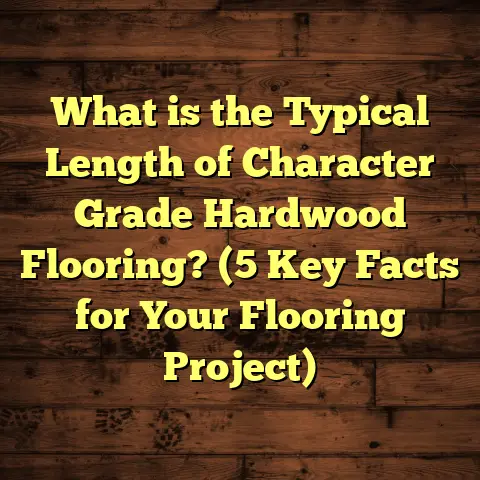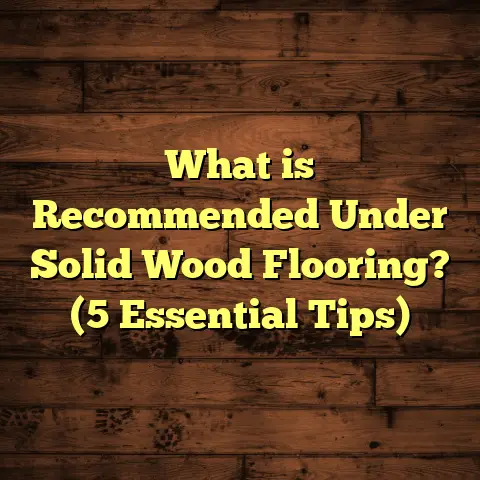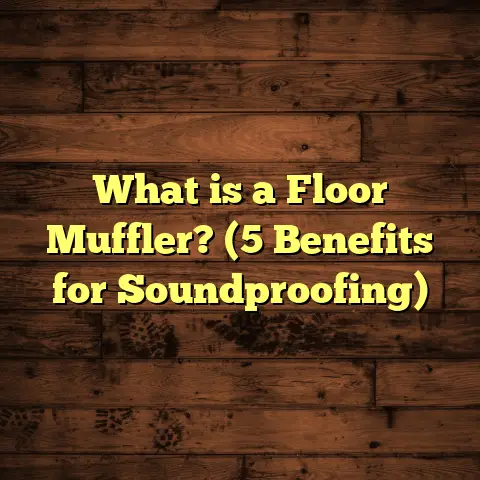What Is Click Lock Flooring? (5 Benefits You Must Know!)
I recently discovered something that felt like a best-kept secret in the world of flooring. It’s called click lock flooring, and honestly, it changed the way I think about installing floors forever. If you’ve ever hesitated before starting a flooring project because of cost, complexity, or fear of a messy installation, this might be exactly what you need to hear.
Allow me to share everything I’ve learned after years of hands-on experience with click lock flooring—from its basics to the big benefits and even some pitfalls I’ve seen along the way.
What Is Click Lock Flooring?
If you’re new to this, you might be wondering: what exactly is click lock flooring? At its simplest, it’s a floating floor system made up of individual planks or tiles that snap together using a locking mechanism built into their edges.
Imagine puzzle pieces fitting perfectly side by side. Instead of nails, glue, or staples holding them down, each plank locks securely into the next by snapping together. Because of this, click lock floors “float” over the subfloor rather than being directly attached to it.
This locking system can be found on several types of flooring materials:
- Laminate: A popular choice because it mimics wood’s look without the price or maintenance.
- Engineered hardwood: Offers a real wood surface with better moisture resistance.
- Luxury vinyl planks (LVP): Waterproof and extremely durable, great for kitchens and bathrooms.
Each type has its own characteristics but shares the same easy installation thanks to the click lock mechanism.
How Click Lock Flooring Stacks Up Against Other Flooring Methods
I’ve installed many floors over the years—solid hardwood nailed down, glue-down vinyl, traditional laminate glued or stapled—and each has its unique challenges.
Nail-down hardwood floors: These require professional tools like nail guns and take time. You also need to wait for finishes to dry. It’s a beautiful, long-lasting option but can be expensive and labor-intensive.
Glue-down vinyl or laminate: This process involves sticky adhesives and demands a pristine subfloor. Mistakes can be costly and messy. Plus, you’re often stuck with drying times and fumes.
Click lock flooring: Here’s where things get interesting. No nails, no glue—just snap the pieces together. It’s faster, cleaner, and often doable by homeowners themselves with basic guidance.
One memorable project was for a client who needed a quick update on a budget. She had no prior experience but was determined to do it herself. We picked vinyl click lock planks, and she finished installation in under two days for a 500-square-foot space. She was thrilled with how straightforward it was.
5 Benefits of Click Lock Flooring You Must Know
1. Easy and Fast Installation Saves Time (and Stress)
What I love most about click lock flooring is how fast it goes down. Years ago, when I worked on a traditional hardwood job, the nailing process alone took days. With click lock floors, the snapping action speeds everything up dramatically.
Professionals report installation time reductions between 30% and 50% compared to glued or nailed floors (National Wood Flooring Association). For DIYers, this means less frustration and quicker enjoyment of your new floor.
The ease comes from the design: no drying times, no nails or staples to hunt down. You simply lay down an underlayment for cushioning and moisture protection (more on that later), then start clicking the planks together row by row.
2. Cost-Effective Without Sacrificing Style
Because it’s faster and simpler, labor costs drop significantly—often cutting installation fees in half compared to traditional hardwood floors. On a recent job, labor for click lock laminate was about $1.50 per square foot versus $3 or more for nailed hardwood.
Material costs vary but are generally lower than solid hardwood while offering great looks. Luxury vinyl click lock planks run between $2 and $5 per square foot depending on brand and quality. Engineered hardwood is more expensive but still usually less than solid wood.
This combination makes click lock flooring an appealing option for budget-conscious projects without compromising aesthetics.
3. Durable Surface That Handles Life’s Little Mishaps
Durability is key when you have kids, pets, or heavy furniture moving around. Click lock floors often come with wear layers rated AC3 or AC4—meaning they resist scratches, dents, and stains well.
For example, I installed laminate click lock flooring in a busy family room over three years ago. Despite constant foot traffic, toys dropped on it, and occasional spills, the floor still looks great today.
Vinyl options add waterproofing on top of durability. They’re perfect for kitchens and bathrooms where moisture can ruin traditional wood floors.
4. Install Nearly Anywhere Over Various Subfloors
One surprising advantage I noticed is how versatile click lock flooring is regarding the surface underneath.
In one basement renovation project, the concrete slab was uneven in spots—too bumpy for glue-down vinyl without extensive leveling. Click lock planks laid over foam underlayment smoothed out minor irregularities and saved us time and money on prep work.
You can install these floors over plywood, existing vinyl, ceramic tiles (if stable), or concrete slabs—provided they’re reasonably flat and clean.
5. Easy Maintenance and Simple Repairs Save Money Over Time
If you’ve ever had to repair a glued or nailed floor plank, you know how painful it can be—usually involving pulling up large sections or professional help.
With click lock flooring, replacing a damaged plank is as simple as unlocking it from its neighbors and swapping it out. No giant mess or expensive service calls are required.
Plus, regular maintenance is straightforward: sweeping or vacuuming plus occasional damp mopping keeps things looking fresh without special cleaners or treatments.
A Closer Look: What Makes Click Lock Flooring Work?
Here’s some inside info about the technology behind that satisfying “click.”
Click lock systems use precision-milled grooves and tongues along plank edges that interlock tightly when pressed or angled together. The design ensures strong mechanical bonding that keeps floors stable without glue or nails.
Some locking profiles use “angle-angle” installation—where you angle one plank into another then press down to lock—while others use “drop-lock” systems that snap in place vertically.
Both methods create tight seams that reduce gaps over time and allow slight expansion/contraction without buckling.
Underlayment: The Unsung Hero
I can’t stress enough how important underlayment is when installing click lock floors.
Underlayment serves several purposes:
- Sound insulation: Minimizes footstep noise—a common concern with floating floors.
- Moisture barrier: Protects flooring from moisture coming up through concrete slabs.
- Cushioning: Adds comfort underfoot and reduces wear on locking joints.
- Minor leveling: Helps smooth out very small subfloor imperfections.
For example, I prefer using foam underlayment with an attached moisture barrier in basements or kitchens where humidity fluctuates. In warmer climates with wood subfloors, simple foam padding works well.
Don’t skip this step! Skipping underlayment can lead to noisy floors and premature wear at locking joints.
Material Differences Within Click Lock Flooring
Though click lock describes the installation method, the actual material varies significantly:
- Laminate: Composed of fiberboard core topped with photographic wood pattern under a protective layer. Affordable with good scratch resistance but sensitive to water.
- Engineered hardwood: Real wood veneer over plywood core. More moisture resistant than solid wood but pricier.
- Luxury vinyl plank (LVP): 100% waterproof plastic layers designed to mimic wood grain or stone textures. Very durable in wet areas.
- Bamboo click lock: A sustainable alternative that also offers durability and unique looks but less common.
Each material suits different needs and budgets—choosing depends on your lifestyle preferences.
Personal Stories from My Flooring Projects
I want to share some real-life experiences that illustrate these points further:
- The Busy Family Room: A couple with three kids wanted durable flooring that looked like hardwood but resisted scratches and spills. We installed AC4-rated laminate click lock flooring over foam underlayment. Two years later? The floor looks nearly new despite hundreds of hours of playtime.
- The Basement Makeover: A homeowner wanted warm-looking floors in his damp basement without breaking the bank. We chose waterproof luxury vinyl click lock planks with a thick attached underlayment for comfort and moisture protection. The entire 800 sq ft project took four days from prep to finish.
- The Rental Property Flip: With quick tenant turnovers expected, the landlord needed something economical yet tough. We went with mid-range vinyl click lock flooring throughout because it handled spills easily and was simple to replace if damaged between tenants.
These examples show how adaptable click lock flooring is across scenarios.
How Much Does Click Lock Flooring Cost?
Let’s break down typical costs based on recent projects:
| Flooring Type | Material Cost (Per Sq Ft) | Installation Cost (Per Sq Ft) | Total Cost (Per Sq Ft) |
|---|---|---|---|
| Laminate Click Lock | $1.50 – $3 | $1 – $2 | $2.50 – $5 |
| Vinyl LVP Click Lock | $2 – $5 | $1 – $2 | $3 – $7 |
| Engineered Hardwood | $3 – $7 | $2 – $3 | $5 – $10 |
| Solid Hardwood | $6 – $12 | $3 – $5 | $9 – $17 |
Keep in mind these numbers vary by region and product quality; however, labor savings on click lock floors are consistent due to faster install times.
What About Longevity? How Long Do These Floors Last?
Lifespan depends largely on material choice:
- Laminate: Typically lasts 10-20 years with care
- Vinyl LVP: 15-25 years; some high-end brands claim longer
- Engineered Hardwood: 20+ years if maintained well
I’ve seen laminate click lock floors still holding up well after 15 years in moderate traffic homes when cleaned regularly and protected from moisture.
Dealing With Moisture: What You Should Know
Moisture challenges are common concerns with floating floors because water can seep under planks causing swelling or warping if materials aren’t water-resistant.
My tips:
- Avoid laminate in bathrooms unless it’s labeled water-resistant.
- Use waterproof vinyl planks in kitchens, basements, bathrooms.
- Always install vapor barriers under floors laid on concrete.
- Clean spills quickly; don’t let water puddle on surface.
- Monitor humidity levels in your home for stable conditions.
Following these rules helps your floor last longer without issues.
Environmental Impact
For those interested in eco-friendliness:
- Bamboo click lock flooring offers sustainability due to rapid bamboo growth.
- Some laminate brands use recycled materials in core boards.
- Vinyl production has environmental concerns but newer products have improved formulations reducing harmful chemicals.
- Engineered hardwood uses less solid wood than traditional hardwoods making it more resource-efficient.
Look for certifications like FloorScore or Greenguard for low VOC emissions if indoor air quality matters to you.
Common Mistakes I’ve Seen (And How You Can Avoid Them)
Even easy-to-install products like click lock flooring come with traps:
- Not acclimating planks before installation leading to expansion issues.
- Skipping underlayment causing noisy floors or moisture problems.
- Installing over uneven subfloors resulting in gaps or damaged locking joints.
- Rushing cuts leading to poor fit at edges.
- Forgetting expansion gaps around room perimeter causing buckling when floor expands.
Taking your time and following manufacturer guidelines helps avoid these headaches.
How Click Lock Flooring Fits Different Design Styles
Whether you want rustic charm or modern sleekness, there’s a click lock product for that:
- Wood-look laminates replicate oak, maple, hickory grains realistically.
- Vinyl planks offer exotic woods or even stone tile patterns.
- Wide plank options create spacious feels; narrow boards give traditional vibes.
- Matte finishes add subtle elegance; glossy surfaces reflect light beautifully.
I always encourage clients to get samples at home where they can see colors in natural light before committing.
Case Study: Office Renovation Using Click Lock Flooring
In one commercial project for a small law office, we installed engineered hardwood click lock flooring throughout 1200 sq ft. The reasons?
- Professional look with real wood surface
- Faster install than traditional glued hardwood
- Ability to remove floor easily if future remodel needed
The client appreciated minimal disruption during installation and loved how easy it was to clean afterward given high foot traffic.
Frequently Asked Questions About Click Lock Flooring
Q: Can I install click lock flooring over radiant heat?
A: Yes! Many engineered hardwoods and vinyl planks are compatible with radiant heat systems but check manufacturer specs first.
Q: Do I need special tools?
A: Basic tools like spacers, tapping blocks, pull bars, saws for cutting are enough for DIY installs.
Q: Can I install in basements?
A: Yes—choose waterproof vinyl or engineered hardwood designed for below-grade applications plus proper underlayment/vapor barriers.
Q: How do I clean these floors?
A: Sweep/vacuum regularly; use damp mop with recommended cleaners avoiding excessive water.
Q: Are there warranties?
A: Most products come with 10–25 year residential warranties covering wear layer damage if installed correctly.
By now you’ve probably realized why click lock flooring feels like an insider secret worth sharing widely. It combines convenience with style and durability at a price many can afford—and I’ve seen firsthand how happy clients become once they try it themselves or hire professionals who know these systems well.
If you’re thinking about new floors, why not give this option serious thought? It could save you time, money, and frustration while giving your home a fresh look that lasts for years.
Got questions about installation tips? Curious about which material fits your lifestyle best? Just ask—I’m here to share everything I know from hands-on experience!





